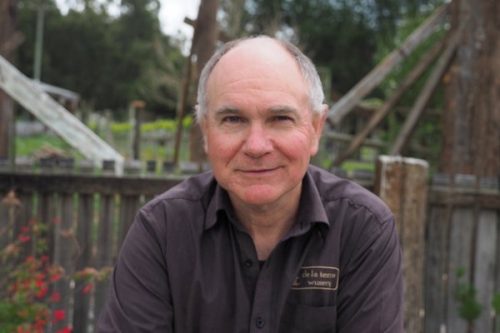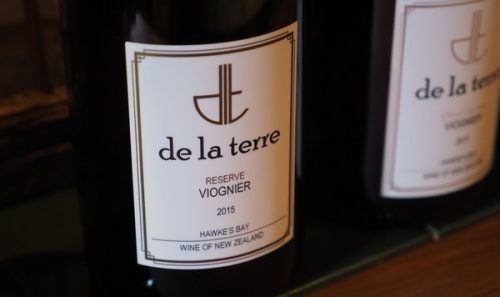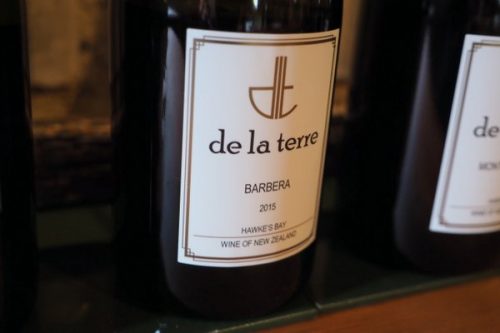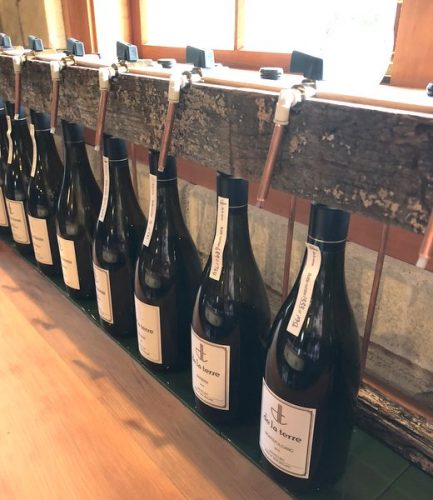
De La Terre is a Hawke’s Bay gem, and it’s the project of Tony and Kaye Prichard. Both started their careers as food technologists. For a long time, Tony was head winemaker for Church Road (1990-2005), but it went through a couple of corporate ownership changes and the feel of the place changed. So he decided to resign and do his own thing. He started working as a consultant winemaker and began building his own winery, in a quiet place off the beaten track, on the edge of Hastings. Before Tony and Kaye started here, it was just a green paddock.
Their vineyard is elsewhere: they have 5.3 hectares on Te Mata Peak. It’s a cluster of eight separate limestone terraces, each with their own distinct terroir. ‘What gives the difference is the variation in slope and contour,’ explains Tony, ‘and also the ratio of limestone to topsoil, and even the amount of limestone. These three factors have a huge influence on the flavour of the wine.’

An example would be the De La Terre Viognier, which Tony thinks tastes more like Chenin than Viognier because of the soils. ‘Kay is a foodie,’ says Tony, ‘and the wine style is all about texture, balance and elegance, not so much varietal definition. It’s all about palate texture and having everything in balance.’
At Church Road Tony worked with Deutz (Champagne) and Cordier (Bordeaux), so there is a bit of a European feel to the wines, deemphasizing the varietal importance. All their wines are made from hand picked, estate fruit. They do all their own bottling. They are trying to get away from the increasing tendency for industrial winemaking.
‘The key to white wines is hand picking,’ says Tony. ‘As soon as you machine harvest you start extraction in the vineyard.’

De La Terre have a new series of wines called Cloud, which are unfined and unfiltered. What drove this was in 2014 he stopped filtering the red wines entirely. The regime now is that he racks every three months, washes the barrels, adjust the sulfur and returns the wine. ‘Filtering is a brutal process,’ he says. ‘It robs some intensity and integrity from the wine.’
He’s also concerned about bentonite additions. ‘They are stupid,’ Tony asserts. ‘I’ve never seen a protein unstable wine yet. And wineries are cooking the samples up at 85 C. Winemakers unnecessarily fret over this, and damage their wines.’
As a consultant Tony says he has seen a lot of brett issues. ‘The easiest way to get brett into a red wine is to have a slightly stuck fermentation,’ he says. ‘Cold soak and wild fermentation are risk factors. Nutrient management is also very important. There’s a three tier risk factor here, and it is not about looking at yeast available nitrogen (YANs) but rather looking at vine vigour, plus brix levels (once you get into 24 you get into dangerous territory) and then adopt a strict molecular sulfur regime. Coinoculating for malolactic fermentation reduces the risk, too. Straight after malolactic fermentation Tony likes to have molecular SO2 running at 0.45-0.5, which can mean up to 45 or 55 ppm free SO2. He’s not keen on acidification: ‘I despise when you see acid in red wines as part of the palate structure.’ So sometimes he works with a pH as high as 3.75. ‘With elevage in barrel the total SO2 doesn’t build up: it oxidises to sulphate.’

In the tasting room, Tony is trying out his new home-made Enomatic-style nitrogen-powered wine dispensing system. It seems to work very well, and cost him just $500, as opposed to perhaps $10 000 if he’d purchased a commercial inert-gas dispensing system. It’s very cool.
De La Terre Cuvée Two 2015 Hawke’s Bay, New Zealand
Blanc de Blancs, two years on tirage. Zero dosage, hand disgorged a la voleee without freezing the neck, recovering the yeast plugs to blend with what is being laid down, in a sort of solera system. They don’t use glycol because of the risk of contamination. Picked at 19.5-19.8 Brix, which is slightly higher than Champagne. Make an effort to get the whole bunch ripe by fruit zone leaf management, which stops the berries at the back being unripe and sour. Tight and focused with lovely compact citrus and pear fruit. Crisp but with a ripe fruit spectrum, with nice ripe fruits, a hint of toast and real harmony and focus. Lovely stuff. 92/100
De La Terre Reserve Viognier 2018 Hawke’s Bay, New Zealand (barrel sample)
Whole-bunch pressed using a Champagne program (low yield of 510 litres/ton). Hyperoxidised must barrel fermented in old barrels. Smooth, seamless and textural with fine acidity and some mineral notes. Very stylish. 92-94/100
De La Terre Ridgeline Viognier 2018 Hawke’s Bay, New Zealand
Hand picked, and pressed with SO2. Primary with nice texture and lush fruit, showing some apricot and pear notes. Has lovely weight. 89-91/100
De La Terre Chardonnay 2014 Hawke’s Bay, New Zealand
Very gentle pressing, with a view to letting the limestone minerality come through. There’s a bit of reduction here with subtle toastiness. Nice finesse with a supple mid palate. Developing nicely. 92/100
De La Terre Reserve Chardonnay 2015 Hawke’s Bay, New Zealand
50% malolactic fermentation. Tony delays SO2 additions for 6 weeks after the malolactic to allow any diacetyl to degrade. 50% new oak. Seamless with hints of toast and whisky, some fine spices, and textured pear and lime fruit. Nice linear acid structure. 93/100
De La Terre Cloud Series Chardonnay 2017 Hawke’s Bay, New Zealand
Fermented in Hungarian oak. Full malolactic. Nutty and mealy with some butterscotch and spice notes, as well as toast. Distinctive. 86/100
De La Terre Barbera 2015 Hawke’s Bay, New Zealand
Tony says that Barbera is the most difficult red he’s ever dealt with. It has small berries with thin skins, and this is a low acid clone. Fresh and linear with nice cherry and plum fruit. Juicy and bright with lovely acid. 90/100
De La Terre Montepulciano 2015 Hawke’s Bay, New Zealand
This is the easiest red Tony works with, giving big bunches with big berries, and thick skins. This is a chunky, grippy wine with fresh red cherries. Restrained fruit, with raspberries and cherries and some ruggedness from the structure. 92/100
De La Terre Reserve Syrah 2015 Hawke’s Bay, New Zealand
Very fine with pepper and clove notes, as well as some spiciness. Supple, expressive and bright with nice precision. Has real elegance and purity. 93/100
De La Terre Cloud Series Syrah 2016 Hawke’s Bay, New Zealand
Supple with nice pepperiness and some fine spicy notes. Supple and drinkable with nice weight and finesse. 93/100
De La Terre Tannat 2016 Hawke’s Bay, New Zealand
From heavy clay soils with no limestone. Refined with nice density and supple black cherry and blackberry fruit. Structured but not too tannic. Expressive with nice texture. 92/100
De La Terre Grande Reserve Tannat 2015 Hawke’s Bay, New Zealand
This is from a special parcel that gets a lot of sun, and it’s 50% new oak. Concentrated with nice depth and fine spiciness. Dark, intense, structured and vibrant with good acidity and notes of cherry, blackberry, plums and spice. Lots of everything, but some restraint and savouriness. 93/100
De La Terre Tempranillo 2018 Hawke’s Bay, New Zealand (cask sample)
Supple and quite light with elegant red cherry fruit, as well as some raspberry. Fine grained and quite elegant. 90-92/100
De La Terre Noble Viognier 2016 Hawke’s Bay, New Zealand
Sweet with ripe apricot and nice citrus fruit, as well as honey and spice. Very stylish and balanced. 93/100
Find these wines with wine-searcher.com
HAWKES BAY
- Tony Bish and The Urban Winery
- Ant Mackenzie, Craft Farm
- Ash Ridge
- Collaboration Wines
- Sileni and their Pinot Noirs
- Paritua
- Clearview Estate
- De La Terre
- Trinity Hill
2 Comments on Hawke’s Bay, New Zealand (8) De La Terre
Hi Jamie, we’re so glad we were able to gatecrash your De La Terre tasting (and also very sorry….!). We had a bottle of the Barbara on Christmas day (in the sunshine!) and it was wonderful, and we have a few more to enjoy over New Year. Hope you managed to get a few back to the UK. Hope you had a very Merry Christmas and have a great New Year.
Lovely! It’s always nice to taste with others!